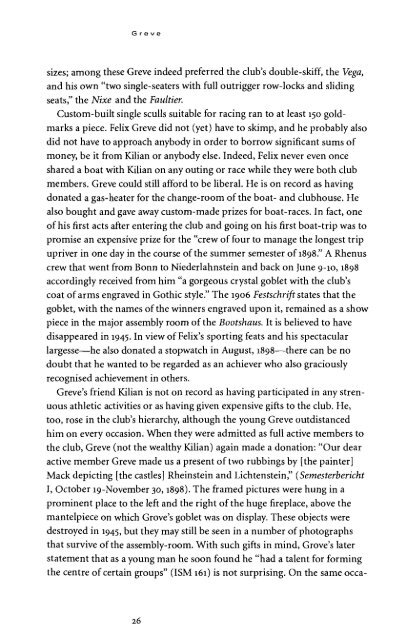Jean Rivard - University of British Columbia
Jean Rivard - University of British Columbia
Jean Rivard - University of British Columbia
Create successful ePaper yourself
Turn your PDF publications into a flip-book with our unique Google optimized e-Paper software.
Grève<br />
sizes; among these Grève indeed preferred the club's double-skiff, the Vega,<br />
and his own "two single-seaters with full outrigger row-locks and sliding<br />
seats," the Nixe and the Faultier.<br />
Custom-built single sculls suitable for racing ran to at least 150 goldmarks<br />
a piece. Felix Grève did not (yet) have to skimp, and he probably also<br />
did not have to approach anybody in order to borrow significant sums <strong>of</strong><br />
money, be it from Kilian or anybody else. Indeed, Felix never even once<br />
shared a boat with Kilian on any outing or race while they were both club<br />
members. Grève could still afford to be liberal. He is on record as having<br />
donated a gas-heater for the change-room <strong>of</strong> the boat- and clubhouse. He<br />
also bought and gave away custom-made prizes for boat-races. In fact, one<br />
<strong>of</strong> his first acts after entering the club and going on his first boat-trip was to<br />
promise an expensive prize for the "crew <strong>of</strong> four to manage the longest trip<br />
upriver in one day in the course <strong>of</strong> the summer semester <strong>of</strong> 1898." A Rhenus<br />
crew that went from Bonn to Niederlahnstein and back on June 9-10,1898<br />
accordingly received from him "a gorgeous crystal goblet with the club's<br />
coat <strong>of</strong> arms engraved in Gothic style." The 1906 Festschrift states that the<br />
goblet, with the names <strong>of</strong> the winners engraved upon it, remained as a show<br />
piece in the major assembly room <strong>of</strong> the Bootshaus. It is believed to have<br />
disappeared in 1945. In view <strong>of</strong> Felix's sporting feats and his spectacular<br />
largesse—he also donated a stopwatch in August, 1898—there can be no<br />
doubt that he wanted to be regarded as an achiever who also graciously<br />
recognised achievement in others.<br />
Grève 's friend Kilian is not on record as having participated in any strenuous<br />
athletic activities or as having given expensive gifts to the club. He,<br />
too, rose in the club's hierarchy, although the young Grève outdistanced<br />
him on every occasion. When they were admitted as full active members to<br />
the club, Grève (not the wealthy Kilian) again made a donation: "Our dear<br />
active member Grève made us a present <strong>of</strong> two rubbings by [the painter]<br />
Mack depicting [the castles] Rheinstein and Lichtenstein," (Semesterbericht<br />
I, October 19-November 30,1898). The framed pictures were hung in a<br />
prominent place to the left and the right <strong>of</strong> the huge fireplace, above the<br />
mantelpiece on which Grove's goblet was on display. These objects were<br />
destroyed in 1945, but they may still be seen in a number <strong>of</strong> photographs<br />
that survive <strong>of</strong> the assembly-room. With such gifts in mind, Grove's later<br />
statement that as a young man he soon found he "had a talent for forming<br />
the centre <strong>of</strong> certain groups" (ISM 161) is not surprising. On the same occa-<br />
26

















